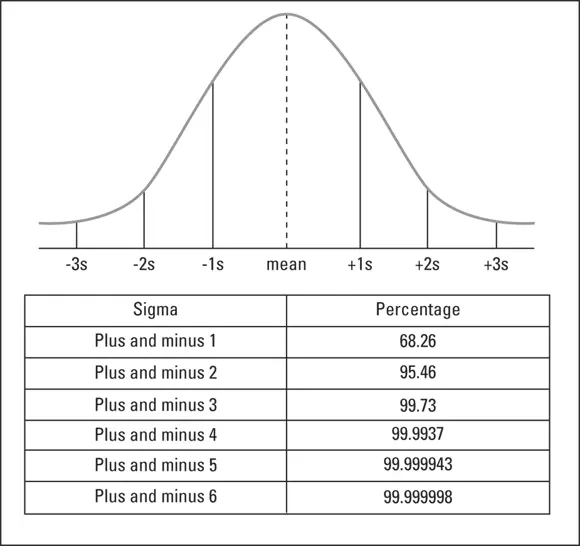x in the formula represents your individual data points
xi represents each x from x1 up to xn
n represents the number of data points in your data set
represents the average (mean) of your data points
represents the “sum of”

© Martin Brenig-Jones and Jo Dowdall
FIGURE 1-3:Standard deviation.
As with most things in life, tackling the formula in stages makes it easier, so let’s have a go.
Start by adding up all of the data points you have. For example, if the data points are 5, 6, 7, 8 and 9 (we’ll demonstrate with some simple ones), the sum is 35. The number of data points we have is 5, so the value of n in the formula is 5. We can then work out the mean (average or  ) of those data points, and the mean (
) of those data points, and the mean (  ) is 7 (because
) is 7 (because  ). Are you with us so far? Great!
). Are you with us so far? Great!
Next we need to work out the  part. This means subtracting the
part. This means subtracting the  value (7) from each of our data points.
value (7) from each of our data points.  , and so on. All is going well, but we now have some negative values in the mix, and we need to get rid of them. This is done by squaring the numbers we’ve just worked out. So
, and so on. All is going well, but we now have some negative values in the mix, and we need to get rid of them. This is done by squaring the numbers we’ve just worked out. So  , and so on. Next, add together all of the answers we just got. If you’re still with us and have done that bit, you should get 10. So now we have real numbers to work with, and the numbers that we put into the formula are
, and so on. Next, add together all of the answers we just got. If you’re still with us and have done that bit, you should get 10. So now we have real numbers to work with, and the numbers that we put into the formula are  (Yes, we did all that work to get to 10 divided by 5.) 10 divided by 5 is 2. We then, finally, take the square root of 2 to get the standard deviation value of 1.41. Hooray!
(Yes, we did all that work to get to 10 divided by 5.) 10 divided by 5 is 2. We then, finally, take the square root of 2 to get the standard deviation value of 1.41. Hooray!
Note that there are two versions of the standard deviation formula included in Figure 1-4. The first is used when we have a sample of data, and the second is used when we have the entire population. The data set we used to work through the example above was very small! If we were using the formula for a sample, instead of using n we’d use  . So we’d end up with
. So we’d end up with  , which is 2.5. The square root of 2.5 is 1.58.
, which is 2.5. The square root of 2.5 is 1.58.

© Martin Brenig-Jones and Jo Dowdall
FIGURE 1-4:Standard deviation formula.
In practice, when the sample size is more than 30, there’s little difference between using n or  . When we refer to a “population,” this could relate to people or things that have already been processed, like, for example, a population of completed and dispatched policy documents.
. When we refer to a “population,” this could relate to people or things that have already been processed, like, for example, a population of completed and dispatched policy documents.
 Now for some good news: You can use a scientific calculator, Excel , or any number of online calculators to work out the standard deviation of your data, without having to worry about this formula.
Now for some good news: You can use a scientific calculator, Excel , or any number of online calculators to work out the standard deviation of your data, without having to worry about this formula.
The Process Sigma values are calculated by looking at our process performance against the customer requirements, which we cover in the next section.
Considering customer requirements
So far so good, but without understanding the customer requirements, it’s not possible to tell whether cycle time performance is good or bad.
Let’s say the customer expects delivery in five days or less. In Lean Six Sigma speak, key customer requirements are called CTQs, (Critical To Quality). We discuss CTQs in Chapter 2and describe them in more detail in Chapter 4, but essentially they express the customers’ requirements in a way that is measurable. CTQs are a vital element in Lean Six Sigma and provide the basis of your process measurement set. In our example, the CTQ is five days or less, but the average performance in Figure 1-2 is four days. Remember that this is the average; your customers experience the whole range of your performance.
 Too many organizations use averages as a convenient way of making their performance sound better than it really is.
Too many organizations use averages as a convenient way of making their performance sound better than it really is.
In the example provided, all the orders that take more than five days are defects for the customer in Six Sigma language. Orders that take five days or less meet the CTQ. We show this situation in Figure 1-5. We could express the performance as the percentage or proportion of orders processed within five days or we can work out the Process Sigma value . The Process Sigma value is calculated by looking at your performance against the customer requirement, the CTQ, and taking into account the number of defects involved where you fail to meet it (that is, all those cases that took more than five days).
We explain the Process Sigma calculation in the next section.
Calculating Process Sigma values
Here are three good reasons for calculating Process Sigma:
It makes you consider customers’ performance needs. How long are they prepared to wait for their order to be processed?
It makes it easier to compare the performance of different processes. If different metrics are used for each process, comparison is tricky, and it’s difficult to prioritize improvements. Process Sigma is a standard quality metric that can be used to measure any process.© Martin Brenig-Jones and Jo Dowdall FIGURE 1-5:Highlighting defects.
It supports decision-making on what performance needs to be, rather than using an arbitrary target. For example, 99.9 percent success sounds impressive, but it would mean 100 plane crashes worldwide every day, and one hour without electricity every month.
The Process Sigma value represents the population of cases that meet the CTQs right first time. Sigma values are expressed as defects per million opportunities (DPMO) to emphasize the need for world-class performance.
Читать дальше


 ) of those data points, and the mean (
) of those data points, and the mean (  ) is 7 (because
) is 7 (because  ). Are you with us so far? Great!
). Are you with us so far? Great! part. This means subtracting the
part. This means subtracting the  value (7) from each of our data points.
value (7) from each of our data points.  , and so on. All is going well, but we now have some negative values in the mix, and we need to get rid of them. This is done by squaring the numbers we’ve just worked out. So
, and so on. All is going well, but we now have some negative values in the mix, and we need to get rid of them. This is done by squaring the numbers we’ve just worked out. So  , and so on. Next, add together all of the answers we just got. If you’re still with us and have done that bit, you should get 10. So now we have real numbers to work with, and the numbers that we put into the formula are
, and so on. Next, add together all of the answers we just got. If you’re still with us and have done that bit, you should get 10. So now we have real numbers to work with, and the numbers that we put into the formula are  (Yes, we did all that work to get to 10 divided by 5.) 10 divided by 5 is 2. We then, finally, take the square root of 2 to get the standard deviation value of 1.41. Hooray!
(Yes, we did all that work to get to 10 divided by 5.) 10 divided by 5 is 2. We then, finally, take the square root of 2 to get the standard deviation value of 1.41. Hooray! . So we’d end up with
. So we’d end up with  , which is 2.5. The square root of 2.5 is 1.58.
, which is 2.5. The square root of 2.5 is 1.58.
 . When we refer to a “population,” this could relate to people or things that have already been processed, like, for example, a population of completed and dispatched policy documents.
. When we refer to a “population,” this could relate to people or things that have already been processed, like, for example, a population of completed and dispatched policy documents. Now for some good news: You can use a scientific calculator, Excel , or any number of online calculators to work out the standard deviation of your data, without having to worry about this formula.
Now for some good news: You can use a scientific calculator, Excel , or any number of online calculators to work out the standard deviation of your data, without having to worry about this formula. Too many organizations use averages as a convenient way of making their performance sound better than it really is.
Too many organizations use averages as a convenient way of making their performance sound better than it really is.










